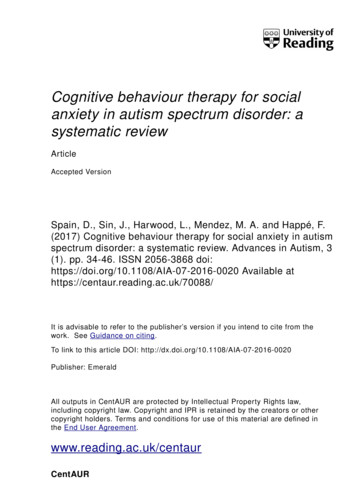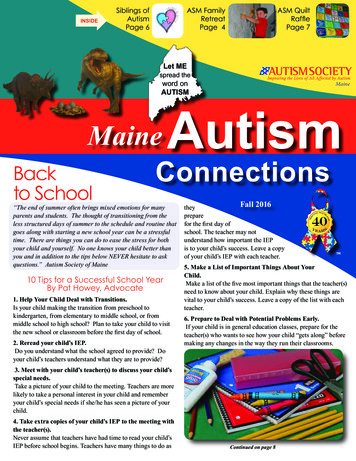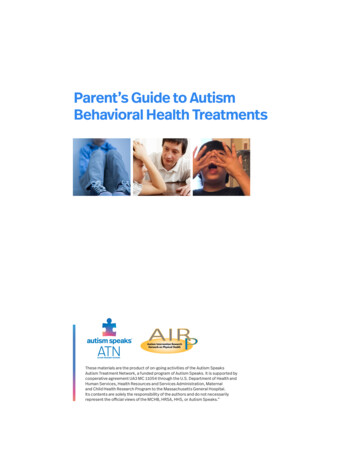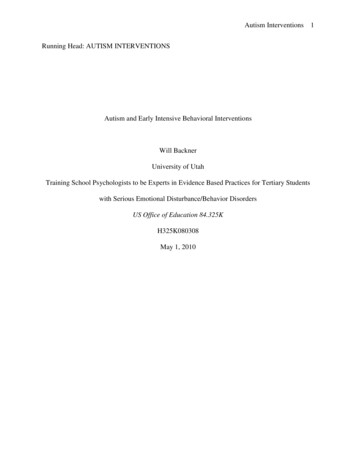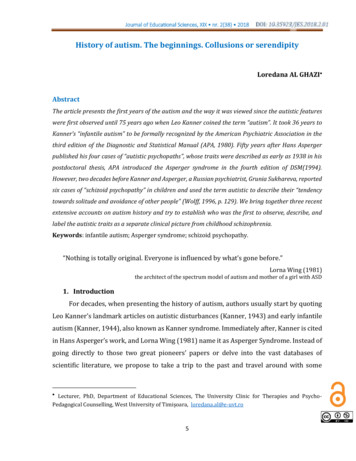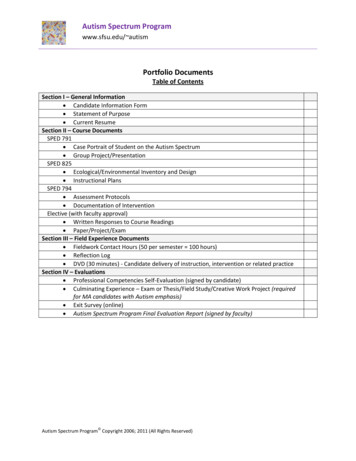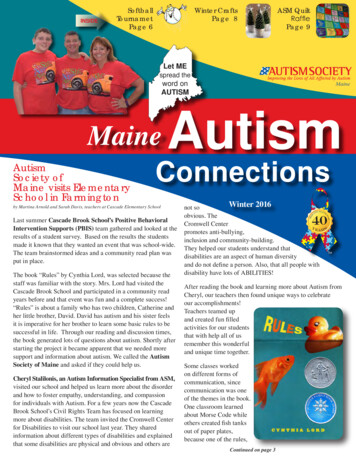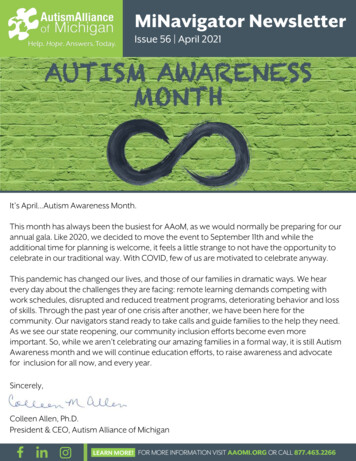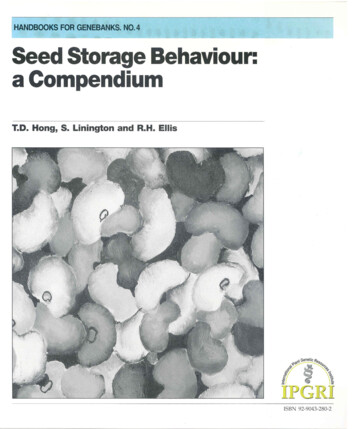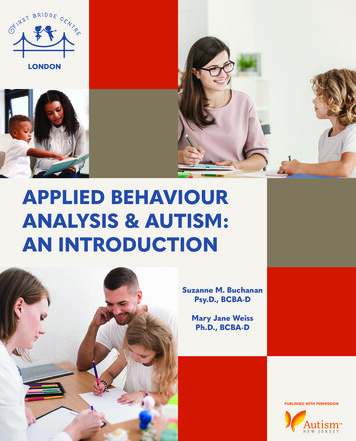
Transcription
LONDONAPPLIED BEHAVIOURANALYSIS & AUTISM:AN INTRODUCTIONSuzanne M. BuchananPsy.D., BCBA-DMary Jane WeissPh.D., BCBA-DPUBLISHED WITH PERMISSION
First Bridge Centre is a fresh start for ABA in the UK. We promise a new beginningfor families who live with early years ASD without a clear sense of choice. Led by thescience, defined by results our only care is the best care for each child we support.Our visionEvery child born with autism should benefit from urgent attention, dedicatedintensive care and the chance to grow and live their best life. Every family shouldknow what’s possible with early evidence-based treatment.Published in the UK with permission. Copyright 2020 First Bridge Centre
ContentsForwardIntroduction: Why ABA?What is ABA?How Behavior Analysts Approach TeachingABCs of BehaviorWhat Principles and Methods Comprise ABA?Evaluation of ABA ProgramsRunning an Intensive ABA ProgramABA and the FamilyABA as a ProfessionMyths & FactsSummaryResource SectionReferencesGive Us Your entShapingPromptsModeling (Imitation Training)Discrete Trial InstructionVerbal BehaviorNatural Environment TrainingPicture Exchange Communication SystemIncidental TeachingPivotal Response TrainingTask Analysis and ChainingToken EconomyActivity SchedulesPrecision Teaching with Rate-BuildingFunctional Assessment and AnalysisAntecedent-Based InterventionsPositive Behavior SupportGeneralization and MaintenanceData collection and analysisDemonstrating a functional relationSiblingsRunning a Home-Based ABA Program
ForwardBoth authors have been profoundly touched by many individuals with autism andtheir families. We have partnered with parents to teach their children and learnedfrom the challenges and joys they experienced while raising a child with autism.Many of these parents consistently requested a written overview that defined anddescribed methods used within Applied Behavior Analysis (ABA) programming.Parents wanted this information during their initial search to better understandthis treatment approach, and during their journey to increase their knowledge andabilities. Unfortunately, only a few such publications have met this need and theycover slightly different topics.This book is intended for those parents and professionals who want an overview ofApplied Behavior Analysis and the meaningful changes it can make in the lives ofpeople with autism. The book is divided into brief segments that focus on specifictopics. Within each section, readers can expect a description or definition of thetopic, examples from everyday settings, and references for further information.References are largely drawn from the professional literature with an emphasis onthose that have a high degree of scientific validity. We hope this book is helpful to youand we welcome your feedback for future revisions.It is important to emphasize that this book is an overview and the resources listedin each section and at the end should be referred to for a more comprehensiveunderstanding of the discussed topics.The authors gratefully acknowledge the peer review of Dr. Sandra Harris and thecontributions of Tamara Bannon, Jenna Miller, Rebecca Hernandez, and ChigusaWeekley to this manuscript.Suggested citation: Buchanan, S. M., & Weiss, M. J. (2010). Applied behavioranalysis and autism: An introduction. Robbinsville, NJ: Autism New Jersey.
IntroductionWhy ABA?There are many autism treatments available,and most of them claim promising results.How do you know if these claims are true? Isthere concrete evidence that the treatmentworks? Choosing the right treatment is inthe best interest of your child and should beworth the commitment and resources. So thequestion is: why ABA?There are many anecdotes that appear tosupport numerous treatments. ABA standsout because its foundation is the collectionand review of direct observational data.There have been hundreds of well-controlledstudies published in the professionalliterature documenting ABA’s effectivenesswith learners with autism (Matson et al.,1996). Most of these studies have focusedon one or two specific behaviors thatrequired intensive teaching or treatment.Some have focused on the learners’ behavioras well as the therapists’ and the parents’behavior during academic and socialinteractions. Approximately ten studies haveexplored the long-term effects of intensiveABA programming for young childrenwith autism. The results of these studieschallenged previous notions that people withautism could not be educated or that theycould not lead meaningful and independentlives. The children who participated in earlyand intensive ABA programming learnedmany new skills and substantially reducedGlossarytheir problematic behavior. Some of thesechildren learned so much that today it is hardto tell them apart from typically developingchildren.While there is still much to learn abouthow early behavioral intervention affectsyoung children with autism, there aresome powerful messages from the studiesconducted so far (Green, 1996). Severalstate and federal agencies have heard thesepowerful messages and agree that there issolid evidence that early and intensive ABAintervention can produce comprehensiveand meaningful improvements for a largeproportion of children with autism (forexample, Maine Administrators of Services3
for Children with Disabilities (MADSEC)Autism Taskforce, 1999; New YorkState Department of Health, 1999; U.S.Department of Health and Human Services,1999).Additionally, the United States Congresscommissioned a panel of autism experts topublish a state of the research on autism andprovide recommendations for public policyand future research (National ResearchCouncil, 2001). While they recognized thecontribution of a behavior-based approach inautism treatment, they pointed out the lackof comparison studies of among this andother popular treatments. The results fromthis type of study would shed more definitivelight on the question of which treatment wasthe best. They stressed the importance ofconducting studies that directly comparedinterventions so that educators and parentscould select the most effective treatment foran individual with autism. Since then, twocomparison studies have been published inpeer-reviewed journals. While there are limitsto how much information can be gleanedfrom only two studies (described below), theresults tells us more about the effectivenessof ABA.How does ABA compare to other treatments?Howard, Sparkman, Cohen, Green, &Stainslaw (2005) published a study onthe effects of three different treatmentapproaches used within early intervention.Sixty-one young children with autismspectrum disorders received one of threetreatment procedures: a) intensive behavioranalytic intervention, b) intensive eclecticintervention which was a combinationof popular methods, or c) non-intensivepublic early intervention. The children werean average of 34 months old when theyentered the study. The study measured eachchild’s skills before and after a 14-monthintervention in the areas of: a) cognitive,b) non-verbal, c) receptive/expressivelanguage, and d) adaptive skills. The results4Introductionof this study showed that children in anintensive ABA program produced significantimprovement across all four areas comparedto the children who received eclectic andnon-intensive treatments. The study evenfound that the children who receivednon-intensive early intervention showed aregression.What about children with autism who entertreatment at a later age? There is someevidence that these children also benefitsubstantially from ABA instruction whencompared to children who participatedin other interventions of similar intensity(Eikeseth, Smith, Jahr, & Eldevik, 2002).The researchers examined the progressof 25 4-7 year olds who received eitherintensive behavioral treatment or intensiveeclectic treatment in public school settings.The results indicated that children whoparticipated in intensive behavioral treatmentmade large improvements across allmeasured skill areas (i.e., cognitive, visualspatial, language, and adaptive behaviorskills) as compared to those children whoreceived intensive eclectic treatment.The same is likely to be true for adults withautism. While there are well-documentedeffects of behavioral assessment andintervention strategies on improvedfunctioning for adults with autism(McClannahan, MacDuff, & Krantz, 2002),there are limited long-term data on intensiveprograms for adults. However, it is clear thatmany adults experience real and substantialgains come from ABA intervention. Thus, itstands to reason that ABA remains a centraland effective component of services forindividuals of all ages with autism.Early and intensive ABA programming iscost effective and potentially life changingfor individuals and their families (Jacobson,Mulick, & Green, 1998). Why not turn toscience and get the best available treatment?When you review the results of the research,you will find ABA.
ResourcesCeliberti, D. A., Buchanan, S. M., Bleeker,F. N., Kreiss, D. S., & Rosenfeld, D. (2004).The road less traveled: Charting a clearcourse for autism treatment. Autism:Basic Information (5th ed., pp. 17-32).Robbinsville, NJ: Autism New Jersey.Matson, J. L., Benavidez, D. A.,Compton, L. S., Paclawskyj, T., & Baglio,C. (1996). Behavioral treatment ofautistic persons: A review of researchfrom 1980 to the present. Research inDevelopmental Disabilities, 17, 433-465.Eikeseth, S., Smith, T., Jahr, E., & Eldevik,S. (2002). Intensive behavioral treatmentat school for 4- to 7-year-old children withautism: A 1-year comparison controlledstudy. Behavior Modification, 26, 49-68.McClannahan, L. E., MacDuff, G. S.,& Krantz, P. (2002). Behavior analysisand intervention for adults with autism.Behavior Modification, 26, 9-26.Green, G. (1996). Early behavioralintervention for autism: What does researchtell us? In C. Maurice (Ed), G. Green, & S.C. Luce (Co-eds.). Behavioral interventionfor young children with autism: A manualfor parents and professionals (pp. 29-44).Austin, TX: PRO-ED.Howard, J. S., Sparkman, C. R., Cohen,H. G., Green, G., & Stainslaw, H. (2005).Comparison of intensive behavior analyticand eclectic treatments for young childrenwith autism. Research in DevelopmentalDisabilities, 26, 359-383.Jacobson, J. W., Mulick, J. A., & Green,G. (1998). Cost-benefit estimates for earlyintensive behavioral intervention for youngchildren with autism--general model andsingle state case. Behavioral Interventions,13, 201-226.MADSEC Autism Taskforce. (1999).Executive summary. Portland, ME:Department of Education.National Research Council (2001).Educating children with autism.Committee on Educational Interventionsfor Children with Autism. C. Lord & J.P. McGee (Eds.) Division of Behavioraland Social Sciences and Education.Washington, DC: National Academy Press.New York State Department of HealthEarly Intervention Program. (1999).Clinical practice guidelines: The guidelinetechnical report – Autism/pervasivedevelopmental disorders, assessment andintervention. Albany, NY: New York StateDepartment of Health.U.S. Department of Health and HumanServices. (1999). Mental health: A reportof the surgeon general. Rockville, MD:U.S. Department of Health and HumanServices, Substance Abuse and MentalHealth Services Administration, Center forMental Health Services, National Institutesof Health, National Institute of MentalHealth.Introduction5
What is ABA?ABA makes meaningful changes in people’slives through the use of procedures thathave been demonstrated to work. Thefollowing description of ABA was adaptedfrom Green (1996).Behavior analytic treatment for autismuses reinforcement in structured andnatural environments to help individualslearn new skills. Skills ranging from simpleto complex are broken down into small,measurable units and systematicallytaught. A high-priority goal is making itenjoyable for the learner. Through carefullyplanned guidance and reinforcement, thelearner is more likely to exhibit appropriatebehavior during and after the teachinginteraction. In contrast, problem behaviorsare not reinforced. Some analysis may benecessary to determine the function(s) andreinforcers for these behaviors to developan effective intervention plan.On a more technical note, Cooper, Heron,and Heward (1987) define ABA as:the science in which proceduresderived from the principles of behaviorare systematically applied to improvesocially significant behavior to ameaningful degree and to demonstrateexperimentally that the proceduresemployed were responsible for theimprovement in behavior. (p. 14)As we said above, ABA makes meaningfulchanges in people’s lives through the use ofprocedures that have been demonstrated towork.During the last fifty years, BehaviorAnalysis has been referred to in a numberof different terms, including behaviormodification, behavior management,contingency management, positiveapproaches, and operant or Skinnerian7
psychology. Most of these terms fail tofully capture the nature and dimensionsof contemporary behavior analysis, andbring with them associations that are eitherinaccurate or misleading. Here is someaccurate information. Behavior AnalysisResourcesCooper, J. O., Heron, T. E., & Heward,W. L. (2007). Applied behavior analysis(2nd ed.). Upper Saddle River, NJ:Prentice Hall.Green, G. (1996). Early behavioralintervention for autism: What doesresearch tell us? In C. Maurice (Ed.), G.Green, & S. Luce (Co-eds.). Behavioralintervention for young children withautism: A manual for parents andprofessionals (pp. 29-44). Austin, TX:PRO-ED.Newman, B. (1999). When everybodycares: Case studies of ABA with peoplewith autism. NY: Dove and Orca.Newman, B., Reeve, K. F., Reeve, S. A.,& Ryan, C. S. (2003). Behaviorspeak:Glossary of terms in applied behavioranalysis (ABA). NY: Dove & Orca.Newman, B., Reinicke, D., & Newman,L. (2000). Words from those who care:Further case studies of ABA with peoplewith autism. NY: Dove and Orca.8What is ABA?has two main branches: experimentaland applied. The experimental analysis ofbehavior is a field of study in which animalsand humans participate in experimentsand researchers observe how they behaveand learn in different situations. The resultsof these studies are then used to informApplied Behavior Analysis, ABA, which isthe service part of the discipline. In otherwords, this type of behavior analyst workswith people to improve their behavior andquality of life.ABA programs are based on empiricalresearch, include the direct observationand measurement of behavior, andutilize antecedent stimuli, positivereinforcement, and other consequencesto produce behavior change. ABA is awell-developed discipline among thehuman service professions. It has amature body of knowledge, establishedstandards for practice, distinct methodsof service, recognized experience andeducational requirements for practice, andidentified sources of requisite education inuniversities.Additional ResourcesThese two resources describe thecharacteristics of Applied Behavior Analysis.While they do not contain information specificto autism, they are quite relevant and providean accurate and thorough picture of theconcepts that guide the field.Baer, D. M., Wolf, M. M., & Risley, T. R.(1968). Some dimensions of applied behavioranalysis. Journal of Applied BehaviorAnalysis, 1, 91-97.Baer, D. M., Wolf, M. M., & Risley, T. R.(1987). Some still-current dimensions ofapplied behavior analysis. Journal of AppliedBehavior Analysis, 20, 313-327.
How Behavior AnalystsApproach TeachingThe behavioral teaching approach takesinto account a few factors, such as thestudent’s current level of performance, theskill acquisition and behavior reductiongoals, and some assumptions about whatcauses behavior (performance) to occur.ABA views the immediate present as thekey to comprehending current behavior,and uses information about the pastcautiously (for example, to understand howa behavioral pattern developed over time).Causes of Behavior1. Genetic explanations - With the humangenome project complete, we nowknow more about how genes affectbehavior. Unfortunately, this informationis not yet helpful in producing amedical treatment or cure for autism.2. Past experiences (sometimes calledreinforcement history or learninghistory) – Behavior analysts study howbehaviors are acquired and maintainedthrough reinforcement. While it isimportant to understand a person’shistory of experiences, this sourcemay yield only limited and insufficientinformation about how to increase aperson’s behavioral skills.3. Immediate environment – the eventsthat are happening during everymoment of our lives. This includes thesetting, other people present and theirbehavior, objects, activities, routines,resources, etc. Behavior analysts seethe immediate environment as themajor cause of behavior. They collectvery specific information about whathappens before and after a behavior.They then use this information tomake appropriate behavior morelikely and inappropriate behavior lesslikely. Parents and teachers can havea tremendous impact on behaviorbecause they are such a large part ofthe child’s immediate environment. So,the more you know about maximizinglearning, the more you can change aperson’s behavior.9
ABCs of BehaviorLet’s look more closely at how behavioranalysts study the interaction between theimmediate environment and behavior.Both the antecedent (the instruction) andthe consequence (eating lunch) influencewhether the behavior will happen again.One of the main things that behavioranalysts do is examine the ABCs:Antecedents, Behavior, andConsequences.Example: Challenging BehaviorAntecedent: what comes before aspecific behaviorBehavior: the behavior itselfConsequence: what happens after aspecific behaviorThis analysis helps to pinpointwhat may trigger a behaviorand assists in identifying whatconsequences keep a behaviorgoing.ABCExample: Teaching ExchangeTeacher says, “Get your lunchbox. It’s timeto eat.” (Antecedent)Student walks to cubby, gets lunchbox,walks to seat at table, and sits down.(Behavior)Teacher says, “Terrific work, Johnny. Yougot your lunchbox. You’re ready to eat.”(Consequence)10Teacher says, “Let’s clean up. It is time forcircle.” (Antecedent)Student throws blocks, lies on floor, andscreams. (Behavior)Teacher says, “We need toclean up our toys,” and helpschild to put blocks in the box.(Consequence)Both the antecedent (theinstruction) and the consequence (notallowed to continue playing) influencewhether the behavior will happen again.In real situations, other factors such as thelearner’s motivation and setting events aretaken into account. These simple examplesare presented for illustration purposes ofthe ABC analysis.What does this mean for me?We can understand how and whenbehaviors occur by examining antecedentsand consequences. We often can changebehaviors by changing what we doimmediately before and immediately afterbehavior.
What Principles and MethodsComprise ABA?
MotivationMotivation is the heart and soul of ABA.Behavior analysts want to know what aperson is motivated by, what interestsher, and what she experiences as fun.The old cliché is true: different strokes fordifferent folks. Perhaps you enjoy a goodmeal of Italian food while another personprefers a backyard barbeque. The sameis true for learners with autism. Motivationis individually determined and bestunderstood by observing the person andhis/her choices. It also is important to keepin mind that motivation can change on amoment-to-moment basis. Even thoughyou like a good barbeque, you probablywouldn’t want one every night of the week.Here’s another example: sometimes youprefer to listen to calm music and othertimes to loud, upbeat music. To maximizethe learner’s fun and performance,behavior analysts encourage him/herto make choices and incorporate thesepreferences into the teaching interaction.This moment-to-moment analysis of thelearner’s motivation can seem like a lotof hard work, which goes above andbeyond the standard curriculum andtypical teaching strategies. So, why is thisimportant and worthwhile? When equippedwith this information, behavior analysts canoffer fun activities, interesting objects, anddesirable items to the learner. The learnerthen associates the instructor with thosefun and desirable items and activities.This often is called pairing yourselfwith reinforcement. It is the essence ofmaking learning fun and of building apositive association with the instructor.The instructor becomes the source of funand desirable items, the person who givessquishy balls, teddy grahams, hugs, highfives, trips to the playground, and giggles.12Motivation alsoABAis aboutunderstandingwhyPrinciples& Methodsa learner engages in a certain behavior,and is very relevant to understandingchallenging behaviors. When weunderstand what a person is motivatedto obtain (attention, a desired object, abreak from instructional demands), wecan reorganize the environment. We canprovide motivating things in the absence ofchallenging behavior and teach the learnerways to appropriately request them.Technically speaking, motivation is oftencalled an “establishing operations” (EO) ora “motivational operation” (MO). They areevents with to properties:1. a reinforcer-establishing effect thatestablishes what is reinforcing in themoment2. an evocative effect that evokes aparticular responseIn simple terms, an EO determines what iswanted and influences what the individualdoes to get the desired item. Here’s anexample with an adolescent with autism.Jason has been outside on a hot day.He gets thirsty and desires water (thereinforcer-establishing effect). We now haveestablished water as a potential reinforcer.The second property, called an evocativeeffect, is demonstrated when Jason doessomething to obtain that reinforcer (water).He might take his teacher’s hand andlead her to the water fountain. He alsomight give her a picture of a glass of water.Thus, the same reinforcer could evokedifferent response at different times or fordifferent people. Responses that have beensuccessful in the past are more likely tooccur than other responses.
MotivationHere’s another example. A child sees apopular toy from a favorite movie in thetoy store. She may want it. This is thereinforcer-establishing effect. Once in thetoy store, she may request the toy becausesuch requests have been honored inthe past. This is the evocative effect. Ifrequests have led to obtaining desiredthings, the likelihood of requesting is highin these situations.This is true for both appropriate andinappropriate behaviors used to requestdesired items. Therefore, this concept alsocan be used to understand how challengingbehaviors emerge. ABA instructors arevery interested in EOs, and in maximizingmotivation in general. UnderstandingEOs significantly increases the success ofinstruction.A student is new to the learningenvironment. The teacher puts out anarray of enticing toys and foods. Shesamples some and plays with some, andwaits for the learner to indicate an interest.As the learner reaches for an item, sheimmediately grants access to the item. Shealso offers praise, hugs and attention whilethe learner eats the snacks and plays withthe toys. She is pairing herself with rewardsand working to identify EOs. She wants toknow what the learner wants. Eventually,she will ask the learner to engage in a brieftask before granting access to the desireditem.ResourcesDelmolino, L., & Harris, S. L. (2004).Incentives for change: Motivating peoplewith autism spectrum disorders to learnand gain independence. Bethesda, MD:Woodbine House.Michael, J. (2000). Implications andrefinements of the establishing operationconcept. Journal of Applied BehaviorAnalysis, 33, 401-410.Sundberg, M. L., & Partington, J. W.(1998). Teaching language to childrenwith autism or other developmentaldisabilities. Pleasant Hill, CA: BehaviorAnalysts, Inc.ABA Principles & Methods13
ReinforcementBehavior analysts knowingly use reinforcementto increase behavior. However, we all usereinforcement every day, in our dealings withother people. We may not call it reinforcement,but it is happening all the time! ReinforcementType 1 ReinforcementType 1 reinforcement (also referred toas positive reinforcement) involves theaddition of something desirable, such aspraise, hugs, a gummy bear, and stickers.Example 1A teacher is instructing Thomas to pointto objects. She puts a ball, a cup, ashoe, a spoon, and a hat on the table.She instructs him to “Touch the shoe.”Thomas touches the shoe. The teacherenthusiastically says, “Hooray! You touchedthe shoe. Now you get to put on yourshoes and go outside.”t Behavior: following an instruction bytouching an itemt Consequence: received praise and achance to go outside and playt Future effect: makes followinginstructions more likely to occur thenext time someone asks him to dosomethingExample 2Johnny sees a friend eating a cookie. Hepoints to the cookie. His mother then giveshim a cookie.t Behavior: pointing to a desired item(cookie) to ask for itt Consequence: received a cookie when(and only when) he asked for itt Future effect: makes pointing to adesired item (cookie) more likely tooccur the next time he sees somethinghe wants14ABA Principles & Methodsinvolves 1) the systematic and immediatedelivery of a consequence (following a behavior)and 2) an increased likelihood that the behaviorwill happen again. In fact, we can only knowthat something is a reinforcer after we watch itseffect on behavior over time. Simply providing apreferred item contingent upon a behavior willnot necessarily result in an increase in behaviorunder similar conditions in the future.Type 2 ReinforcementType 2 reinforcement (also referred toas negative reinforcement) involves theremoval of something undesirable.Example 1We turn off an alarm clock to stop theloud repetitive sound.t Behavior: touching “off” button onclockt Consequence: removingundesirable alarm soundt Future effect: makes “touchingoff-button” behavior more likely tooccur the next time alarm soundsExample 2At McDonald’s Playland, a child isoverwhelmed by the loud noises. Thechild requests to leave, saying “car, car.”The family leaves.t Behavior: requesting to go homet Consequence: exiting reducesexposure to undesired noiset Future effect: makes requesting togo home more likely to occur thenext time child experiences highnoise level
ReinforcementBoth positive and negative reinforcementincrease behavior by making the learner’s lifebetter.t generalized reinforcers such as tokens andmoney that allow access to a range of otherprimary and secondary reinforcers.A note on negative reinforcement: The commondefinition and the ABA definition of negativereinforcement are different. As previouslymentioned, the ABA definition refers to anincrease in behavior when something annoyingis stopped or prevented because of our behavior.In contrast, the common use of the term is asynonym for punishment. These terms canlead to confusion. The important piece to focuson is the learner’s behavior and what happensfollowing the behavior. If the learner repeatedlybehaves in ways that result in escape oravoidance of something undesirable, negativereinforcement is in effect. Readers are referredto text books on ABA for further information andclarification.Effective programming makes use of both typesof reinforcement to maximize the learner’sprogress. The behavior analyst’s goal is to movetoward the type and schedule of reinforcementthat will maintain the behavior in typical settings.It can be tempting to think of preferred itemsas reinforcers. Yet, before doing so, it mustbe demonstrated that the contingent use ofthe preferred item is the reason for a behaviorincrease; only then can the item be called areinforcer. For learners with autism, some itemsand activities are more likely to be reinforcersthan others. Primary reinforcers serve abiological function and include food, water,warmth, and sexual stimulation. Initially, learnerswith autism may be more responsive to primaryreinforcers. Secondary reinforcers gain theirpotency because they were paired with primaryreinforcers or other established secondaryreinforcers.There are four types of secondary reinforcers:t tangible reinforcers such as trinkets andtoys,t activities-oriented reinforcers such asplaying a game and going to the movies,t social reinforcers such as physical contactand verbal praise, andResourcesCooper, J. O., Heron, T. E., & Heward,W. L. (2007). Applied behavior analysis(2nd ed.). Upper Saddle River, NJ:Prentice Hall.Hall, R. V., & Hall, M. L. (1998). How toselect reinforcers (2nd ed.). Austin, TX:PRO-ED.Leaf, R., McEachin, J., & Harsh, J.D. (Eds.). (1999). A work in progress:Behavior management strategies &a curriculum for intensive behavioraltreatment of autism (pp. 23-36). NewYork, NY: DRL Books.Miller, L. K. (1996). Principles ofeveryday behavior analysis (3rded.). Pacific Grove, CA: Brooks/ColePublishing Company.ABA Principles & Methods15
ShapingShaping is a way to reinforce improvementin behavior. Shaping is used to graduallyteach the learner how to do somethingbetter. Over time, an instructor rewardsattempts that look more like the desiredbehavior. Thus, the learner is encouragedthrough reinforcement to exhibit moreappropriate behavior. While shapingbehavior can be a slow process, it canbe quite effective if done correctly. Thisprocess requires that the teacher has bothintimate knowledge of the learner and theability to shift gears based on the learner’sperformance. One of the positive effects ofshaping includes decreasing frustration byproviding feedback to the learner that he/she is on the right track. Learning becomesmore rewarding because there are manyopportunities for reinforcement along theway.When shaping behavior, there are severalthings to remember. First, shaping is bothan art and a science. The t
Applied Behavior Analysis and the meaningful changes it can make in the lives of people with autism. The book is divided into brief segments that focus on specific . Behavior analysis and intervention for adults with autism. Behavior Modification, 26, 9-26. National Research Council (2001). Educating children with autism.

